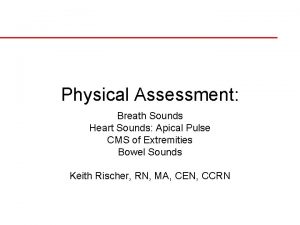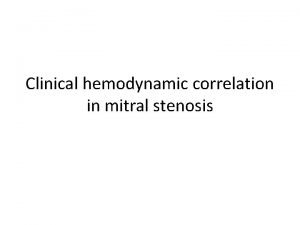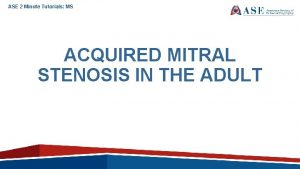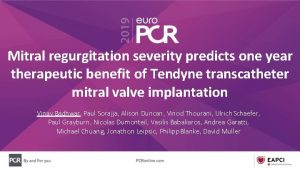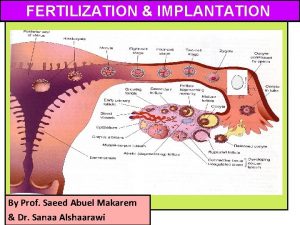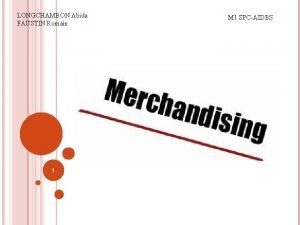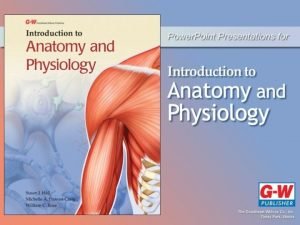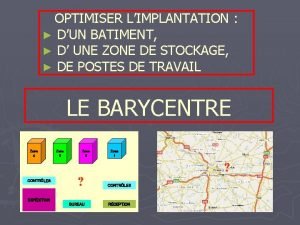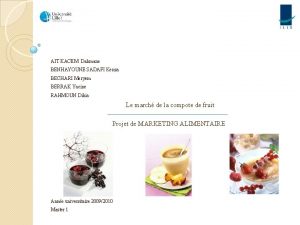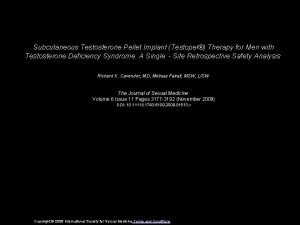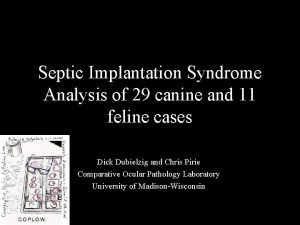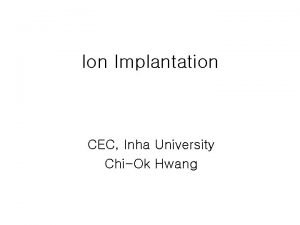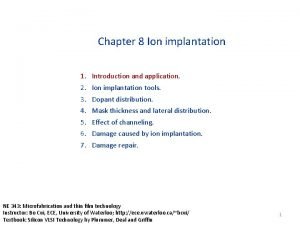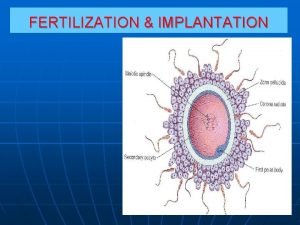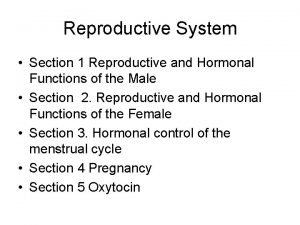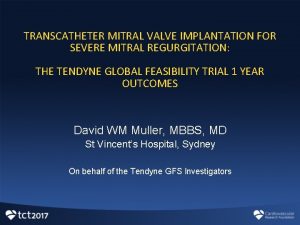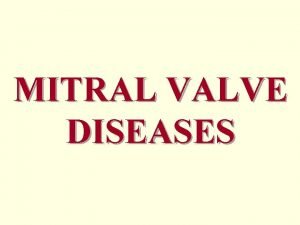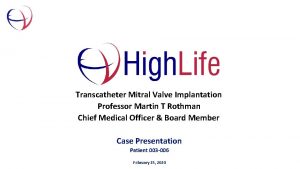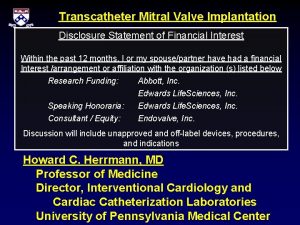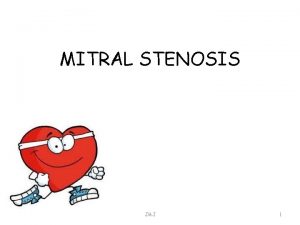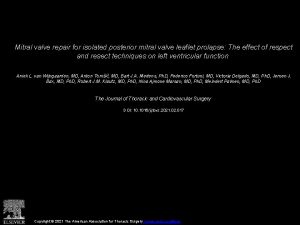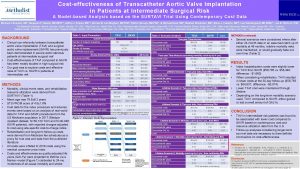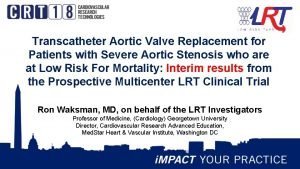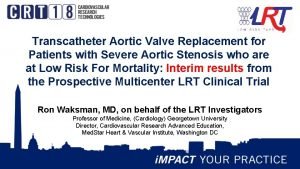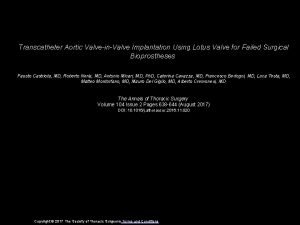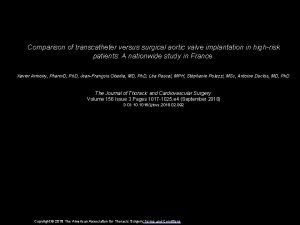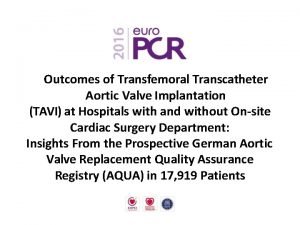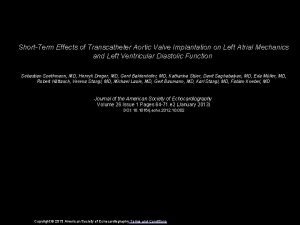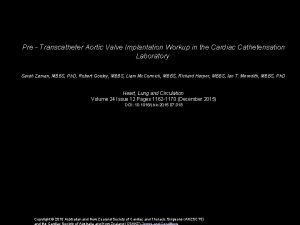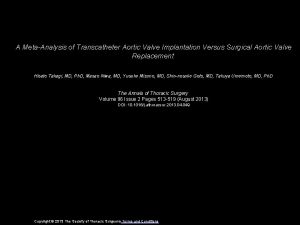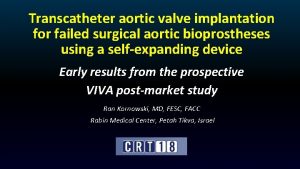Transcatheter mitral valve implantation in patients with severe


















- Slides: 18

Transcatheter mitral valve implantation in patients with severe mitral annular calcification: early results from the Tendyne MAC Study Paul Sorajja MD, Vasilis Babaliaros MD, Vinay Badhwar MD, Bassem Chehab MD, Vinod Thourani MD

Disclosures • Mario Gössl MD, presenting on behalf of authors • Consultant and Subject Eligibility Committee Chair for Abbott Vascular

Why this study? • MAC predisposes to mitral regurgitation, often precludes surgical treatment • Poor 2 -year prognosis in MAC / significant MR when left untreated 1 60. 5% 36. 5% 1 Ahmed A, Cavalcante J, Gössl M, Garberich R, Bae R, Tang L, Niikura H, and Sorajja P. Prevalence and Prognosis of Mitral Disease due to Mitral Annular Calcification, AATS Mitral Conclave Oral Presentation, May 3, 2019.

Results from TMVR in MAC Global Registry • Previous studies of treatment of mitral valve disease in severe MAC demonstrated the feasibility of using balloon expandable aortic valve prostheses 2 • Associated with high 30 -day mortality (25%) Procedural Outcomes N= 116 Technical success* 89 (76. 7%) Need for second valve 17 (14. 7%) LVOT obstruction* 13 (11. 2%) Cardiac perforation 2 (1. 7%) Conversion to open heart surgery 4 (3. 4%) MV reintervention 9 (7. 8%) 30 -day mortality 29 (25%) * MVARC-defined 2 Guerrero M, Urena M, Himbert D, Wang DD, Eleid M, et al. 1 -Year Outcomes of Transcatheter Mitral Valve Replacement in Patients with Severe Mitral Annular Calcification. JACC 2018; 71(17): 1841 -1853.

Results from Tendyne Compassionate Use 3 Severe MAC successfully treated under CU , motivating a dedicated MAC study Procedural Outcomes Technical success* Need for second valve N=8 7 (87. 5%) 0 (0%) LVOT obstruction* 1 (12. 5%) Cardiac perforation 0 (0%) Conversion to open heart surgery 0 (0%) MV reintervention 0 (0%) 30 -day mortality 0 (0%) * MVARC-defined. 1 subject had valve malposition resulting in LVOT obstruction 3 Sorajja P, Gössl, M, Babaliaros V, et al. Novel Transcatheter Mitral Valve Replacement in Severe Mitral Annular Calcification. Submitted to JACC

Study Design Symptomatic, Severe MR (30 Subjects) Objective: Evaluate feasibility of the Tendyne system for the treatment of MR in subjects with severe MAC Sample Size: Up to 10 sites, 30 subjects in the US Per local Site Heart Team: Subject meets inclusion/exclusion criteria AND is not a suitable candidate for conventional surgical treatment due to degree of MAC Patient Screening for anatomical suitability Echo Core Lab Review CT Core Lab Review PI review and discussion Primary Safety Endpoint: Device Success and freedom from device- or procedure-related SAEs at 30 days TMVI Procedure Clinical and Echo Follow-Up Discharge, 30 Days, 3 months, 6 months, 1 year, annually through 5 years

Tendyne TMVI Design APICAL PAD • Placed over ventricular access site TETHER DESIGN • Separates sealing from securement • Enables full retrievability VALVE DESIGN • Variety of valve sizes and profiles to address broad range of patient anatomies Low Profile (LP) Standard Profile (SP) Increased LVOT with Low Profile

Case Study 1: Caseous Calcification Predicted Baseline Information Age 72 Gender Male NYHA III STS-PROM 5. 8% Cardiac Rhythm Atrial Fibrillation History of Hypertension Mild Prior Valve Intervention No MAC Volume (mm 3) 3777 vs. Actual Result

Case Study 1: Caseous Calcification Predicted vs. Actual Result

Case Study 2: Small Mitral Annulus Predicted Baseline Information Age 73 Gender Female NYHA II STS-PROM 5. 6% Cardiac Rhythm Atrial Fibrillation History of Hypertension Mild Prior Valve Intervention Tricuspid repair MAC Volume (mm 3) 2348 vs. Actual Result

Case Study 2: Small Mitral Annulus Predicted vs. Dimensions (mm) SL: 22. 9 IC: 30. 6 Perimeter: 91. 1 Actual Result Dimensions (mm) SL: 30. 3 IC: 36. 7 Perimeter: 110. 4

Case Study 3: Prior TAVR Predicted Baseline Information Age 73 Gender Male NYHA III STS-PROM 5. 5% Cardiac Rhythm Atrial Fibrillation History of Hypertension Mild Prior Valve Intervention TAVR 3 Volume of MAC (mm ) 4794 vs. Actual Result

Case Study 3: Prior AVR Predicted vs. Actual Result

Baseline Demographics • 6 patients have been treated in MAC Feasibility Study (through May 6, 2019) Baseline Demographics Age Female • 38% (8/21) screen pass rate • High-risk population n=6 78. 8 ± 9. 3 3 (50%) NYHA ≥ III 5 (83. 3%) STS score 9. 37 ± 11. 15 Prior AVR 2 (33. 3%) Prior CABG 3 (50%) Atrial Fibrillation 5 (83. 3%) History of Myocardial Infarction 1 (16. 7%) Renal Failure (GFR<60) 2 (33. 3%) Lung Disease/COPD 2 (33. 3%) History of Hypertension 6 (100%) CV Hospitalization in past 12 months 3 (50%)

Baseline Imaging Measurements • Preserved EF, non-dilated LV • Small annular dimensions • Significant calcium burden Baseline Echo Measurements n=6 LVEF (%) 60. 1 ± 6. 7 Mean Mitral Valve Gradient (mm. Hg) 4. 4 ± 1. 9 (5) MR Grade ≥ 3+ 100% (5) LVESD (cm) 3. 8 ± 0. 7 LVEDD (cm) 5. 5 ± 0. 3 LVEDVi (m. L/m 2) 63. 6 ± 14. 4 (5) Estimated RVSP (mm. Hg) 41 ± 19. 3 (3) Mean LVOT gradient (mm. Hg) 1. 8 ± 0. 9 (5) Baseline CT Measurements n=6 SL Dimension (mm) 25. 4 ± 2. 2 Intercommissural Dimension (mm) 34. 1± 5 Annular Perimeter (mm) 101. 6 ± 9. 8 AML Length (mm) 16. 9 ± 3. 9 Volume of MAC* (mm 3) 4130 ± 1789 *All core lab measurements except volume of MAC

Procedural / Post-Procedural Outcomes • 100% technical success, with no conversions to surgery • No LVOT Obstruction, or MV reintervention • No 30 d mortality Procedural Data* n=6 Technical Success** 6 (100%) Concomitant Balloon Valvuloplasty 4 (66. 7%) Post-procedure Outcomes* Pre-discharge (n=6) 30 -day (n=4) All-cause death 0 0 Stroke 0 0 Myocardial Infarction 0 0 MV Reintervention 0 0 Pre-discharge (n=4) 30 -day (n=4) LVOTO** 0 0 MR – transvalvular 0 0 PVL 0 0 5. 3 ± 0. 6 4. 4 ± 0. 9 Procedural Death 0 Procedural Stroke 0 Valve Embolization ECMO or CPB 0 Follow-up Imaging data Valve Embolization 0 Valve Retrieval 0 Conversion to Open Heart Surgery 0 *AEs site-reported MV Gradient (mm. Hg) **MVARC-defined

Why is this important? • TMVI is a potential therapy for patients with severe MR and at prohibitive surgical risk due to MAC • Pre-procedural planning using CT is essential for determining anatomic suitability and accurately predicting prosthesis interaction with MAC

The essentials to remember • 100% technical success, no conversions to surgery, no LVOT obstruction, no MV reintervention • No 30 -day mortality • Tendyne’s unique design and safety features, including ability to reposition or retrieve, make it suitable for use in severe MAC
 Apical pulse and mitral valve
Apical pulse and mitral valve Ef slope in echo
Ef slope in echo Pressure half time formula
Pressure half time formula Tendyne
Tendyne Servo valve function
Servo valve function Implantation
Implantation Implantation verticale et horizontale
Implantation verticale et horizontale Early pregnancy pictures of spotting during pregnancy
Early pregnancy pictures of spotting during pregnancy Lesson 15.4 ovulation fertilization and implantation
Lesson 15.4 ovulation fertilization and implantation Implantation batiment methode
Implantation batiment methode Implantation verticale et horizontale
Implantation verticale et horizontale What does a testosterone pellet look like
What does a testosterone pellet look like Grand rendez-vous sst
Grand rendez-vous sst Pickwickian syndrome in dogs
Pickwickian syndrome in dogs The perverse implantation summary
The perverse implantation summary Ion implantation
Ion implantation Ion implantation
Ion implantation Implantation
Implantation Function of testes
Function of testes
